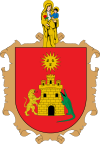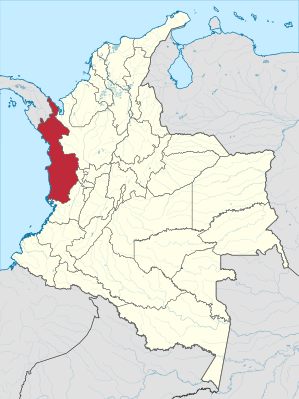Department of Chocó
| Data | |
|---|---|
| Capital | Quibdó |
| governor | Jhoany Carlos Alberto Palacios Mosquera (2016–2019) |
| surface | 46,530 km² |
|
Population (Total) - 2005 Census - Population Density |
441,395 10 inhabitants / km² |
| urbanization | 36% |
| Literacy rate | 65.3% |
| Number of parishes | 31 |
| Popular name | chocoano |
| Important cities | Istmina, Riosucio |
| map | |
| Location of Chocó in Colombia | |
The Departamento del Chocó is a department in northwest Colombia . It borders the Pacific and Panama to the west and the Atlantic to the north . To the east lie the Departamentos de Antioquia and Risaralda . In the south, Chocó borders the Valle del Cauca department . In addition to the capital Quibdó, there are 29 other municipalities in Chocó . At the 2005 census, 441,395 people lived in Chocó.
history
Little is known about the time before the Chocó was colonized. The first conquistador , Rodrigo de Bastidas , came across an area populated by Indian tribes in 1501. His successor was Vasco Núñez de Balboa . Until 1821, the area of today's Chocó Department was divided into the two provinces of Chocó and Popayán . Two years after Spain recognized Colombia's independence , a new province of Chocó was formed in 1821. This had today's borders, but was subordinate to the control of the Cauca Department . After the independent province was revived between 1831 and 1857, the province became part of the Cauca Department. After being raised to Intendencia in 1909, three years later he was appointed comisaría . In its current form, the Department was established by Act No. 13 of 1947. Since then, Quibdó has been the capital of Chocó.
economy
In addition to forestry , fishing , mining and agriculture are of particular economic importance. In addition to wood, one of the most important sources of income is gold. Most of the other industries are poorly developed. There are conflicts with indigenous and Afro-Colombian communities who own the land over the expansion of mining.
The beaches of Bahía Solano and Nuquí are the main tourist regions of the province. Both places can only be reached by plane from Medellín or Quibdó.
Administrative division
The 31 municipalities of Chocó are in the list of Municipios in the Departamento del Chocó .
Web links
- Article in the Biblioteca Luis Ángel Arango on the Chocó; Retrieved October 28, 2008
Individual evidence
- ↑ Counting of the DANE 2005 for the Chocó (PDF; 5 kB)
- ↑ Emma Gascó, Martín Cuneo: The conflict in the Chocó. ( Memento of March 8, 2014 in the Internet Archive ) NPLA, January 9, 2014




